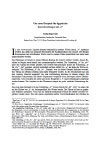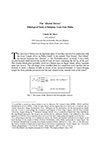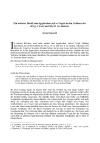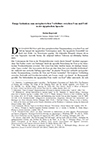philology
« Vier neue Beispiele fuÌr Ă€gyptische Kurzschreibungen mit âbâ »
ENiM 8, 2015, p. 33-36.
 Cet article Ă©tudie quatre nouveaux exemples de lâĂ©criture abrĂ©gĂ©e par âbâ. Le premier exemple montre que âbâ pouvait remplacer âḥbâ âfĂȘteâ. Le deuxiĂšme consiste en lâĂ©criture âb.tâ pour âʿb.tâ âlaitueâ, comme cela est discutĂ© par les chercheurs depuis quelque temps ; le spectre est ici Ă©largi par trois nouvelles interprĂ©tations. Le quatriĂšme et dernier exemple est âbâ pour âbȝqâ âbriller, ĂȘtre clairâ. Autant que possible, les explications sont phonĂ©tiques.
Cet article Ă©tudie quatre nouveaux exemples de lâĂ©criture abrĂ©gĂ©e par âbâ. Le premier exemple montre que âbâ pouvait remplacer âḥbâ âfĂȘteâ. Le deuxiĂšme consiste en lâĂ©criture âb.tâ pour âʿb.tâ âlaitueâ, comme cela est discutĂ© par les chercheurs depuis quelque temps ; le spectre est ici Ă©largi par trois nouvelles interprĂ©tations. Le quatriĂšme et dernier exemple est âbâ pour âbȝqâ âbriller, ĂȘtre clairâ. Autant que possible, les explications sont phonĂ©tiques.
 In this paper, four further Egyptian spellings with âbâ are scrutinized. In the first case, it be-comes clear, that âbâ can stand for âḥbâ âfeastâ. In the second one, it will be demonstrated that â according previous explanations â âb.tâ may be an abbreviation for âʿb.tâ = âʿbwâ âlet-tuceâ. Here, three other alternatives are suggested. In the third case, it will be shown that âbâ can be used for âwʿbâ âwʿbâ-priest. The fourth example is represented by the writing âbâ for âbȝqâ âbright, shiningâ.
In this paper, four further Egyptian spellings with âbâ are scrutinized. In the first case, it be-comes clear, that âbâ can stand for âḥbâ âfeastâ. In the second one, it will be demonstrated that â according previous explanations â âb.tâ may be an abbreviation for âʿb.tâ = âʿbwâ âlet-tuceâ. Here, three other alternatives are suggested. In the third case, it will be shown that âbâ can be used for âwʿbâ âwʿbâ-priest. The fourth example is represented by the writing âbâ for âbȝqâ âbright, shiningâ.
 Consulter cet article (44715) -
Consulter cet article (44715) -  Télécharger cet article au format pdf (23898)
Télécharger cet article au format pdf (23898)
« The âAbaton Decreeâ. Philological Study of Religious Texts from Philae »
ENiM 14, 2021, p. 21-54.
 Dans cet article, Ch. De MarĂ© propose une nouvelle Ă©dition annotĂ©e du DĂ©cret divin concernant lâAbaton, la source majeure Ă propos de lâAbaton de Biggeh, la tombe locale dâOsiris. Les termes du DĂ©cret incluent principalement des dispositions rituelles journaliĂšres et des interdictions ayant cours autour de la sĂ©pulture dâOsiris. Ce texte, gravĂ© sur la Porte dâHadrien Ă Philae, a Ă©tĂ© conservĂ© Ă travers deux versions, ici traduites et mises en contexte avec le souci dâĂ©tablir des liens entre les deux versions. BasĂ©e sur des photographies de haute qualitĂ©, cette Ă©tude vise Ă fournir, aux chercheurs et aux Ă©tudiants, une base solide et une rĂ©flexion approfondie au sujet de questions dâinterprĂ©tation posĂ©es par les incertitudes qui demeurent. En effet, une attention particuliĂšre a Ă©tĂ© consacrĂ©e aux lacunes et aux ambiguĂŻtĂ©s prĂ©sentes dans les inscriptions, et de nouvelles pistes sont proposĂ©es en marge de lâĂ©dition. Lâobjectif est dâamĂ©liorer la comprĂ©hension des tombes mythiques et des pratiques rituelles osiriennes. Une rĂ©flexion est prĂ©sentĂ©e notamment sur le rythme des pĂšlerinages dâIsis vers lâAbaton.
Dans cet article, Ch. De MarĂ© propose une nouvelle Ă©dition annotĂ©e du DĂ©cret divin concernant lâAbaton, la source majeure Ă propos de lâAbaton de Biggeh, la tombe locale dâOsiris. Les termes du DĂ©cret incluent principalement des dispositions rituelles journaliĂšres et des interdictions ayant cours autour de la sĂ©pulture dâOsiris. Ce texte, gravĂ© sur la Porte dâHadrien Ă Philae, a Ă©tĂ© conservĂ© Ă travers deux versions, ici traduites et mises en contexte avec le souci dâĂ©tablir des liens entre les deux versions. BasĂ©e sur des photographies de haute qualitĂ©, cette Ă©tude vise Ă fournir, aux chercheurs et aux Ă©tudiants, une base solide et une rĂ©flexion approfondie au sujet de questions dâinterprĂ©tation posĂ©es par les incertitudes qui demeurent. En effet, une attention particuliĂšre a Ă©tĂ© consacrĂ©e aux lacunes et aux ambiguĂŻtĂ©s prĂ©sentes dans les inscriptions, et de nouvelles pistes sont proposĂ©es en marge de lâĂ©dition. Lâobjectif est dâamĂ©liorer la comprĂ©hension des tombes mythiques et des pratiques rituelles osiriennes. Une rĂ©flexion est prĂ©sentĂ©e notamment sur le rythme des pĂšlerinages dâIsis vers lâAbaton.
 In this paper, Ch. De MarĂ© presents a new annotated edition of the âAbaton Decreeâ, the main Egyptian source that describes the Abaton of Biggeh, the local tomb of Osiris. The terms of the Decree mainly include daily ritual requirements and prohibitions concerning the burial sanctuary of Osiris. This text, carved on Hadrianâs Door on Philae, preserved through two versions, is translated and put in context by making interconnections. Based on high-quality photographs, this study aims at offering both researchers and students with a solid basis and in-depth reflection on questions of interpretation raised by the remaining uncertainties. Indeed, particular attention has been given to the gaps and ambiguities of the inscriptions, and new tracks are proposed in the margins of the edition. The purpose is to improve understanding of Osirian mythical tombs and ritual practices. A reflection is notably provided on the rhythm of the periodical boat journeys of Isis to the Abaton.
In this paper, Ch. De MarĂ© presents a new annotated edition of the âAbaton Decreeâ, the main Egyptian source that describes the Abaton of Biggeh, the local tomb of Osiris. The terms of the Decree mainly include daily ritual requirements and prohibitions concerning the burial sanctuary of Osiris. This text, carved on Hadrianâs Door on Philae, preserved through two versions, is translated and put in context by making interconnections. Based on high-quality photographs, this study aims at offering both researchers and students with a solid basis and in-depth reflection on questions of interpretation raised by the remaining uncertainties. Indeed, particular attention has been given to the gaps and ambiguities of the inscriptions, and new tracks are proposed in the margins of the edition. The purpose is to improve understanding of Osirian mythical tombs and ritual practices. A reflection is notably provided on the rhythm of the periodical boat journeys of Isis to the Abaton.
 Consulter cet article (37087) -
Consulter cet article (37087) -  Télécharger cet article au format pdf (16092)
Télécharger cet article au format pdf (16092)
« Ein weiteres Detail zum Ă€gyptischen Ćnfr.w-Vogels in den GrĂ€bern des HwyÈ, IÊżáž„-mĆ und Mry-RÊż zu Amarna »
ENiM 14, 2021, p. 323-327.
 La prĂ©sente contribution poursuit la discussion sur le nom dâoiseau Ă©gyptien ?nfr.w. Le mot apparaĂźt dans trois tombes privĂ©es dâAmarna. La connexion suggĂ©rĂ©e prĂ©cĂ©demment avec le corbeau est renforcĂ©e par trois nouveaux exemples. Les deux premiers proviennent de lâEspagne mauresque, tandis que le troisiĂšme exemple est dâorigine indienne. La beautĂ© du plumage noir joue le rĂŽle dĂ©cisif.
La prĂ©sente contribution poursuit la discussion sur le nom dâoiseau Ă©gyptien ?nfr.w. Le mot apparaĂźt dans trois tombes privĂ©es dâAmarna. La connexion suggĂ©rĂ©e prĂ©cĂ©demment avec le corbeau est renforcĂ©e par trois nouveaux exemples. Les deux premiers proviennent de lâEspagne mauresque, tandis que le troisiĂšme exemple est dâorigine indienne. La beautĂ© du plumage noir joue le rĂŽle dĂ©cisif.
 The present contribution continues the discussion of the Egyptian bird name snfr.w. The word occurs in three private tombs from Amarna. The previously suggested connection with the raven is supported by three new examples. The first two examples come from Moorish Spain, while the third example is of Indian origin. The beauty of the black plumage plays the decisive role.
The present contribution continues the discussion of the Egyptian bird name snfr.w. The word occurs in three private tombs from Amarna. The previously suggested connection with the raven is supported by three new examples. The first two examples come from Moorish Spain, while the third example is of Indian origin. The beauty of the black plumage plays the decisive role.
 Consulter cet article (30681) -
Consulter cet article (30681) -  Télécharger cet article au format pdf (15174)
Télécharger cet article au format pdf (15174)
« Einige Gedanken zum metaphorischen VerhĂ€ltnis zwischen Frau und Feld in der Ă€gyptischen Sprache »
ENiM 15, 2022, p. 287-294.
 Dans cette contribution, est Ă©tudiĂ©e la relation entre la femme et le champ dans la langue Ă©gyptienne. La documentation montre clairement que lâassociation « joue » dans les deux directions. Le tertium comparationis rĂ©side dans lâaspect de fĂ©conditĂ©. Les exemples couvrent une pĂ©riode qui sâĂ©tend de lâAncien Empire Ă la pĂ©riode grĂ©co-romaine.
Dans cette contribution, est Ă©tudiĂ©e la relation entre la femme et le champ dans la langue Ă©gyptienne. La documentation montre clairement que lâassociation « joue » dans les deux directions. Le tertium comparationis rĂ©side dans lâaspect de fĂ©conditĂ©. Les exemples couvrent une pĂ©riode qui sâĂ©tend de lâAncien Empire Ă la pĂ©riode grĂ©co-romaine.
 In this contribution, the relationship between woman and field in the Egyptian language is investigated. The material shows very clearly that the association has worked in both directions. The idea presents itself, that the tertium comparationis can be found in the aspect of fecundity. The examples cover a timespan stretching from the Old Kingdom to the Greco-Roman Period.
In this contribution, the relationship between woman and field in the Egyptian language is investigated. The material shows very clearly that the association has worked in both directions. The idea presents itself, that the tertium comparationis can be found in the aspect of fecundity. The examples cover a timespan stretching from the Old Kingdom to the Greco-Roman Period.
 Consulter cet article (21787) -
Consulter cet article (21787) -  Télécharger cet article au format pdf (9926)
Télécharger cet article au format pdf (9926)
« Einige vorlĂ€ufige Bemerkungen zum Ă€gyptischen Lautwandel zwischen âáž„â und ânâ »
ENiM 16, 2008, p. 43-46.
 Dans cette contribution, le changement de son en Ă©gyptien entre « ? » et « n » est examinĂ© plus en dĂ©tail. La recherche nâa pas encore accordĂ© beaucoup dâattention Ă ce phĂ©nomĂšne. Dans cet article, neuf exemples sont prĂ©sentĂ©s pour illustrer ce phĂ©nomĂšne phonĂ©tique.
Dans cette contribution, le changement de son en Ă©gyptien entre « ? » et « n » est examinĂ© plus en dĂ©tail. La recherche nâa pas encore accordĂ© beaucoup dâattention Ă ce phĂ©nomĂšne. Dans cet article, neuf exemples sont prĂ©sentĂ©s pour illustrer ce phĂ©nomĂšne phonĂ©tique.
 In this contribution, the Egyptian sound change between â?â and ânâ is examined in more detail. Research has not yet paid much attention to the phenomenon. In this article, nine examples are presented to illustrate this phonetic phenomenon.
In this contribution, the Egyptian sound change between â?â and ânâ is examined in more detail. Research has not yet paid much attention to the phenomenon. In this article, nine examples are presented to illustrate this phonetic phenomenon.
 Consulter cet article (26792) -
Consulter cet article (26792) -  Télécharger cet article au format pdf (7734)
Télécharger cet article au format pdf (7734)
ENiM 18 - 2025
4 article(s) - 11 mars 2025.
ENiM 1 à 18 (2008-2025) : 223 articles
4 023 055 téléchargements
8 341 976 consulations.
Index des auteurs

Mots clés

Derniers articles : 
Robert Steven Bianchi
Duplication and Continuity
(ENiM 18, p. 13-36 — 11 mars 2025) 
Frédéric Mougenot
Rénénoutet à la porte de la maison
(ENiM 18, p. 1-12 — 29 janvier 2025) 
CENiM - Mise en ligne des volumes Ă©puisĂ©s : 
 Anne-Sophie von BOMHARD DĂ©cans Ă©gyptiens, CENiM 23, Montpellier, 2020 — (2020)
Anne-Sophie von BOMHARD DĂ©cans Ă©gyptiens, CENiM 23, Montpellier, 2020 — (2020) 
 Jean-Claude Grenier L'Osiris ANTINOOS, CENiM 1, Montpellier, 2008 — (26 dĂ©cembre 2008)
Jean-Claude Grenier L'Osiris ANTINOOS, CENiM 1, Montpellier, 2008 — (26 dĂ©cembre 2008) 
TDENiM - Mise en ligne des volumes Ă©puisĂ©s : 
 Twitter
Twitter 3617334 visites - 10967 visite(s) aujourd’hui - 48 connecté(s)
© ENiM - Une revue d’égyptologie sur internet
Équipe Égypte Nilotique et Méditerranéenne - UMR 5140 - « Archéologie des Sociétés Méditerranéennes » (Cnrs) - Université Paul Valéry - Montpellier III


























 Contact
Contact
 Abonnez-vous !
Abonnez-vous ! Équipe Égypte Nilotique et Méditerranéenne
Équipe Égypte Nilotique et Méditerranéenne UMR 5140 « Archéologie des Sociétés Méditerranéennes » (Cnrs)
UMR 5140 « Archéologie des Sociétés Méditerranéennes » (Cnrs) Université Paul Valéry - Montpellier III
Université Paul Valéry - Montpellier III